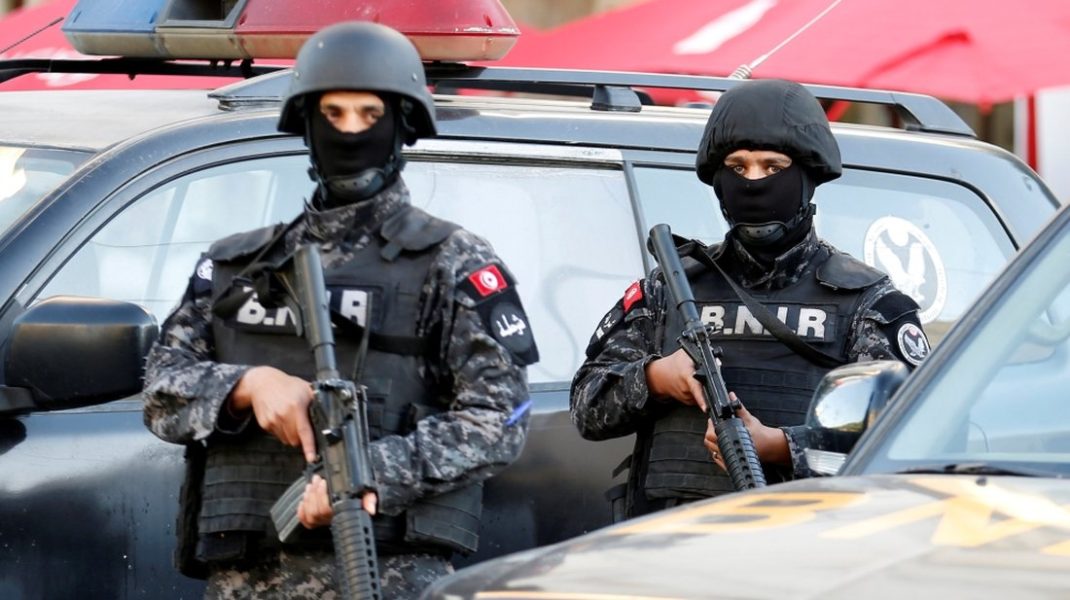By Frederic Wehery
 The escalation and spillover of Libya’s conflict has posed mounting security challenges for Tunisia and exposed shortfalls in the country’s defense transformation, in the areas of capability gaps, interagency coordination, intelligence sharing, strategic planning, and in the military’s relationship with foreign security patrons.
The escalation and spillover of Libya’s conflict has posed mounting security challenges for Tunisia and exposed shortfalls in the country’s defense transformation, in the areas of capability gaps, interagency coordination, intelligence sharing, strategic planning, and in the military’s relationship with foreign security patrons.
PART ONE
INTRODUCTION
In the pre-dawn hours of January 27, 1980, scores of armed fighters stormed through the mining town of Gafsa in southern Tunisia, firing on police and military installations and attempting to rally the town’s disgruntled inhabitants to revolt against the Tunisian government.
Fighting continued for days, resulting in the deaths of dozens of security forces and the uprising’s ultimate failure. In subsequent weeks, the Tunisian government accused Muammar Gadafi’s regime in Libya of orchestrating, training, and funding the incursion.
The Gafsa Incident, as it came to be called, underscored the severity of the threats emanating from Tunisia’s unpredictable eastern neighbor. It was also a jolt to Tunisia’s defense establishment, exposing gaps in critical capabilities.
As they scrambled to respond, the Tunisian armed forces suffered from serious shortfalls in mobility and logistics and were forced to rely on the rapid injection of Moroccan and French support.
In the aftermath of the battle, the Tunisian Ministry of Defense (MOD) sought to remedy these military deficiencies. “Gafsa was the start of our modernization,” noted one retired Tunisian general in an October 2019 interview.
In tandem, Tunisia’s Western backers, worried about a continued threat from Libya’s mercurial and aggressive regime, also responded.
A year after the attack, the administration of then president Ronald Reagan announced it was bolstering its security assistance to Tunisia. But Pentagon officials at the time were divided about the direction of that assistance—whether it should prepare the Tunisian military to address conventional threats, from tanks and aircraft, for example, or less conventional ones, like insurgents and terrorists.
They received little helpful input from the Tunisian military, which, because of the Tunisian regime’s policy of neglecting the armed forces, lacked even a rudimentary capacity for planning and forecasting requirements.
Tunisian officials presented the U.S. military with what amounted to a wish list of expensive, high-end equipment.
More than three decades later, Tunisia faced another cross-border attack emanating from Libya, which, like the Gafsa Incident, involved an effort to seize an entire Tunisian town by exploiting its economic marginalization.
In the morning darkness of March 7, 2016, more than fifty militants of the self-proclaimed Islamic State—some of whom had been trained at a camp near the Libyan town of Sabratha—streamed across the Libyan-Tunisian border into the town of Ben Gardane and proclaimed an “emirate.”
Tunisian police and army forces fought running gun battles with the insurgents for several days, eventually defeating them with some civilian help and at the cost of many lives. As in the case of Gafsa, the Ben Gardane assault was a shock to the Tunisian defense establishment, laying bare deficiencies in military capabilities and preparedness.
And, just as the Gafsa battle had done, the aftermath of Ben Gardane, along with earlier Islamic State attacks, spurred a rush of Western security assistance. Here again, however, the Tunisian armed forces’ requests for outside assistance were not rooted in a Tunisian-led strategy or planning process.
However, in the years since, the Tunisian armed forces have made impressive progress in multiple areas. This is especially evident when compared to their decades-long marginalization before the 2011 revolution against then president Zine El-Abidine Ben Ali.
During this seminal event, they emerged with newfound popularity among many sectors of Tunisian society, especially when compared to Ministry of Interior (MOI) forces, who had sided with the regime.1
In the immediate postrevolution period, the Tunisian military assumed a large number of roles, ranging from law enforcement to the guarding of critical infrastructure to disaster relief and even the protection of Tunisia’s national exam facilities.
With the rise of terrorism on Tunisian soil in 2013 and, especially, by mid-2014—much of it originating in or linked to Libya—the Tunisian military started focusing more on asymmetric threats and handing some enforcement and infrastructural protection missions back to the MOI.
While not without its problems, the Tunisian military’s transformation has been steady and significant, according to many foreign and Tunisian accounts.
The Tunisian armed forces are moving from an outmoded, neglected, Cold War–style conventional force into a leaner, more agile, and more responsive military capable of executing a diverse set of missions.
U.S. officials who have trained the Tunisians over the years are quick to emphasize this dynamism and they caution against judging Tunisia’s shortcomings—especially in areas such as joint (in other words, intermilitary service) operations, information sharing, and civil-military relations—against the standard of wealthy industrial states such as the United States.
When compared to other partner nations of the United States on the African continent, one U.S. military officer noted, the Tunisians’ progress is remarkable. “They are working on differential equations,” this officer observed, “while other African partners are doing arithmetic.”
Still, the legacy of decades of official neglect of the Tunisian military and entrenched bureaucratic rivalries weigh heavily on the present—as does the unpredictable future of Tunisia’s larger neighbors.
Current and future threats from the most consequential of these neighbors, Libya, have exposed deficiencies at the tactical, operational, and strategic levels of Tunisia’s defense capabilities.
A number of steps are needed to remedy these gaps. The country’s defense leadership needs to engage in a more deliberate planning effort to organize and equip their military to account for Libya’s potential trajectories over the next ten to twenty years.
And most importantly, this process needs to be organic and delinked from the priorities of Tunisia’s foreign patrons, especially the U.S. Department of Defense (DOD), which has thus far exerted a disproportionate influence on steering the Tunisian military toward combatting terrorists.
Moving toward these reforms does not mean that Tunisia’s military should be the first or only policy tool in dealing with challenges from Libya—far from it.
As research by Carnegie and other scholars has argued, and as the Tunisian military itself recognizes, addressing the issue of Tunisian-Libyan border instability demands, first and foremost, a holistic policy of socioeconomic reform and inclusive governance.
WHY ARE CHALLENGES FROM LIBYA SO CONFOUNDING?
Libya is a vital national security concern for Tunisia because of its outsized effects on the country’s economic development and political stability. The World Bank attributes at least 24 percent of Tunisia’s overall drop in the growth of gross domestic product from 2011 to 2015 to Libya’s turmoil.
The fall in remittance income from Tunisia’s expatriate workers in Libya who have returned to Tunisia because of the violence has been sharp, dropping by roughly 32 percent from 2010 to 2014.
The remaining Tunisian workers in Libya are exposed to increased dangers and sometimes threats of expulsion from Libyan authorities as retaliation for the Tunisian government’s arrests of Libyans. On top of this, there have been other effects on Tunisia.
The first several years after the fall of Qadhafi saw an influx of Libyan refugees into Tunisia, straining parts of the economy, especially by raising rent prices. And while those numbers have diminished as some Libyans returned home, the Tunisian government is preparing for another spike if Libya’s conflict worsens.
Spillover jihadist violence, epitomized by the Ben Gardane assault as well as other Islamic State attacks originating in Libya, has deterred foreign investment and tourism, though there are recent and encouraging signs of a recovery. muggling and trafficking from Libya, over land and maritime borders, remain a continuing concern.
The endemic turnover of officials and governments in Tripoli has compounded the aforementioned challenges, leaving Tunisia without a viable diplomatic or security partner. “You don’t know who your neighbor is,” said one Tunisian army officer. “Today it is John, tomorrow it is Tom.”
This uncertainty contrasts sharply with the Algerian border which, despite being the site of a low-grade insurgency, at least presents Tunisia with strong state partner on the other side. In Libya, however, there is an utter lack of formal and centrally controlled border security units with whom the Tunisian military can engage.
Instead, a dizzying array of fractious Libyan armed groups and tribes (many with kin across the border) hold sway, along with smugglers.
Navigating this landscape is tricky for Tunisia’s armed forces, both in terms of acquiring accurate and actionable intelligence but also in terms of doctrine and legality. “We are obliged to talk to the militias—to ‘work’ with them,” said one Tunisian army officer; “we can’t ignore them.”
This landscape became suddenly more complex for Tunisia on April 4, 2019, when militia forces allied with eastern-based strongman General Khalifa Haftar attacked Tripoli with the intention of toppling the internationally backed Government of National Accord (GNA).
Ostensibly undertaken to clear the capital of militias, the move is more accurately seen as a grab for power by Haftar—what the United Nations special representative for Libya has correctly called a “coup.”
The largely stalemated war has introduced a worrying array of high-end weaponry to western Libya, with serious implications for Tunisia’s security: Javelin and Kornet antitank missiles, heavy-caliber mortars, shoulder-fired surface-to-air missiles, and perhaps most significantly, armed drones piloted by the United Arab Emirates (backing Haftar) and Turkey (backing the GNA), whose operational radius extends into Tunisian territory.
In early September 2019, the situation escalated even further with the arrival to the Tripoli front of over 100 Russian mercenaries from the so-called Wagner Group in support of Haftar, bringing with them tactical expertise that aided his advance.
This was followed by the deployment in late December 2019 of thousands of Turkish-backed Syrian militia fighters to bolster the GNA’s front lines.
Tunisia’s response to this endemic chaos has been, for the most part, centered on disciplined noninterference, choosing diplomacy over active military meddling—or at least not meddling to the extent of other Middle Eastern actors (principally, the United Arab Emirates, Turkey, Egypt, Jordan, and Qatar) who have provided funding, logistics, weapons, fighters, and advisors, and even conducted airstrikes in Libyan territory.
Instead of picking sides, Tunisia has tried to stay “equidistant” from all factions, according to one Tunisian officer. Officially, the Tunisian government engages with the GNA and maintains a small consulate in the Libyan capital.
Even so, Tunisian military officers acknowledge GNA Prime Minister Fayez al-Sarraj’s tenuous to nonexistent control over the armed groups that claim nominal affiliation to his government, and they recognize the value of maintaining channels to Haftar.
This is even the case with Tunisian officials expressing concerns about his behavior, especially if he takes power in Tripoli. “We are not sure how Haftar will behave toward us; he’s not happy with democracy,” noted one Tunisian military intelligence officer.
But they are adamant about maintaining the perception of neutrality.
The Tunisian-Libyan border remains mostly open—though it is subject to intermittent closures by the Tunisian government—and Libyans from both factional camps are free to travel to Tunisia for meetings and dialogues.
Wounded Libyan fighters from both Haftar’s forces and the GNA receive medical care in Tunis, albeit in separate hospitals and clinics.
***
Frederic Wehrey is a senior fellow in the Middle East Program at the Carnegie Endowment for International Peace. His research deals with armed conflict, security sectors, and identity politics, with a focus on Libya, North Africa, and the Gulf.
_____________





